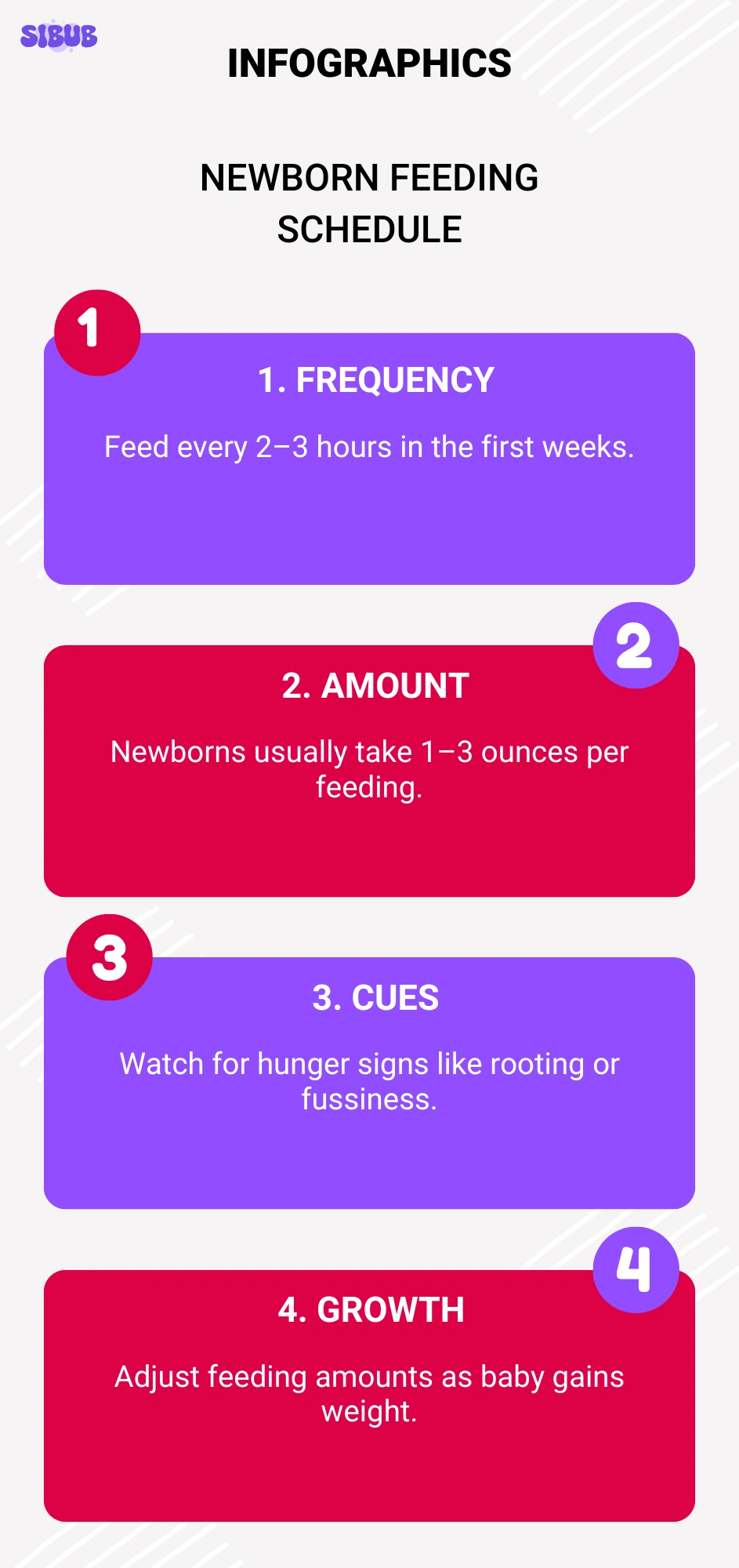Newborn babies do not come with user guides, but one of the most crucial things that first-time parents need to learn is how to establish the right newborn feeding schedule.
Everything you need to know, including how frequently to feed, how much your baby should eat, etc., is answered in this guide.
What Is a Newborn Feeding Schedule?
A newborn feeding schedule is a normal pattern upon which the frequency and amount that a newborn is to feed during the day and night are measured.

Regardless of how you are feeding your baby, whether through breastfeeding or formula feeding, your baby needs a feeding schedule to ensure they receive the right proportion of nutrients for proper growth, weight gain, and overall health.
What does a baby eat?
What is the number of calories that a baby requires? How should the feeding program be?
This varies depending on the age of the baby and whether the baby is on breastmilk or formula. A general rule is here:
- Day 1-3: 1 to 1.5 oz per feeding (formula or colostrum)
- Week 1: 1 to 2 ounces per feeding
- Week 2: 2 to 3 ounces in 2-4 hr intervals
- Month 1: 2 ounces every 3-4 hours
As your milk belly enlarges, the quantity that your infant consumes grows.
Never disregard the cues from your baby in connection with the hunger levels so as to determine feeding duration and quantity.
How much should a newborn eat
You might think how often to feed newborn? Well, use a Newborn feeding schedule of around 2-3 hours apart from each other in the 24hours of a day. That means:
- Infants who are breastfed make 8-12 feeds in a day
- The breast-fed children will need between 12 and 24 feedings each day
The infant may have different needs according to how hungry they are, and this varies, so it is always advisable to feed on demand when the baby presents hunger signs by sucking hands, lips smacking, or whining.
Baby feeding chart
Although babies are different, here is a simplified version of the chart of baby feeding:
| Age Range | Volume per Feeding | Feedings per Day |
|---|---|---|
| Birth to 1 Week | 1–2 oz | 8–12 |
| 1 to 2 Weeks | 2–3 oz | 8–10 |
| Up to 4 Weeks | 3–4 oz | 7–9 |
| 1 to 2 Months | 4–5 oz | 6–8 |
| 3 Months to 3 Years | 5–6 oz | 5–7 |
Baby feeding times: Formula vs breastfeeding
Infant Feeding Schedule and Breastfed Babies Vs. Formula-Fed Babies
The feeding pattern of an infant is contingent upon the type of feeding that one uses. They are discussed below:
Breastfed Babies
- They absorb milk at a quicker rate, hence become hungry more quickly
- Normally, get fed at least every 2-3 hours interval
- The cluster feeding is natural; this implies that they might feel like feeding several times within a short time.
Formula-Fed Babies
- Take a little longer than breast-fed youngsters. Try again
- Typically get fed every 3-4 hours
- It is simpler to follow the amounts of ounces of drinks they take in.
Regardless of the approach you use, be mindful of your baby showing hunger signs in order to feed him or her as soon as he or she seems hungry.
When do babies start eating baby food?
Babies usually become ready to eat baby food at age 6 months.

Before this age, they can only survive on breast milk or formula to be healthy and grow.
It is also possible to feed some babies at an early age, leaving their digestive system disturbed, because it is only at 6 months of age that the digestive system is fully developed.
Newborn feeding amount (0-3 days)
An example of a newborn feeding schedule at 1 month is as follows:
- Ask him how he slept and offer him some milk or juice around 6:00 am, where he would be given about 3 to 4 ounces of milk (breastmilk or formula).
- Start another feeding at 9:00 AM, and repeat the amount of 3 to 4 ounces. At about 1200 PM, you may further give the amount gradually to 4 ounces and give another 4-ounce feeding at 3:00 PM.
- Give another 4 ounces around 6:00 PM and then another 3 to 4 ounces around 9:00 PM.
- At night, feed your baby 3 ounces at 12:00 AM and 3:00 AM.
The newborn feeding schedule and amounts should be adjusted according to your baby and their hunger and weight gain, and advised by their pediatrician.
Tips for Feeding Your Newborn Parents
Here are some tips that you can follow for a newborn feeding schedule:

- Track feedings: An app or even a notebook to track feedings is one of the ways to keep track
- Burp baby after feeding: Prevents the occurrence of gas and fussiness
- Don’t push additional ounces: Let the baby make the choice when they are satisfied
- The growth spurts: the additional feedings: be an open brain to the baby to the feeding timetable.
Final Thoughts
Establishing a stable newborn feeding schedule allows your baby to develop healthily and strongly, with the added benefit that you are at ease.
Have a baby eating chart and know the amount of newborn feeding you need, having no clue on how frequently to feed a baby, well, just be adaptive.
Not all babies are the same; therefore, they need some slight differences in it, and it is all good.
